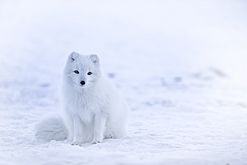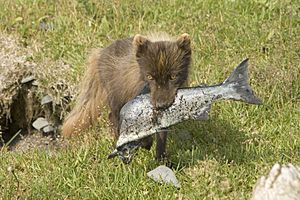Arctic fox facts for kids
Quick facts for kids Arctic fox |
|
|---|---|
 |
|
| Scientific classification | |
| Kingdom: | |
| Class: | |
| Order: | |
| Family: | |
| Genus: | |
| Binomial name | |
| Vulpes lagopus |
|
 |
|
| Arctic fox range | |
The Arctic fox (Vulpes lagopus) is an omnivorous animal, meaning it eats both plants and meat. It belongs to the dog family. This amazing animal is also known as the white fox, polar fox, or snow fox. It lives in the very cold Arctic tundra areas of northern Europe, northern Asia, and North America. You can find Arctic foxes high up in mountains, even 9,800 feet (3,000 meters) above sea level. They have even been seen on the sea ice near the North Pole! Some of the animals that hunt Arctic foxes are golden eagles, Arctic wolves, polar bears, wolverines, red foxes, and grizzly bears.
Contents
Arctic Fox Body and Fur
The Arctic fox is about 10 to 12 inches (25–30 cm) tall and weighs from 6.5 to 21 pounds (2.7-4.5 kg). Female foxes are usually a bit smaller than males. The Arctic fox has a round body, a short nose, short legs, and small, fluffy ears. This round shape helps it stay warm because less of its body is exposed to the freezing cold air. It has very thick fur that is brown in summer and turns white in winter. Baby foxes, called pups, are born with brown fur that changes to white as they grow up.
There are two main fur colors, called "morphs," that are passed down through genes: white and blue.
- The white morph is bright white in winter. In summer, its fur turns brown on its back and light gray on its belly.
- The blue morph stays a dark blue, brown, or gray color all year round.
About 99% of Arctic foxes are the white morph. White morphs mostly live inland, away from the sea, where their white fur helps them blend in with the snowy tundra. Blue morphs usually live near the coast, where their darker fur helps them hide among the cliffs and rocks.
-
Arctic fox in winter fur, Iceland
How Arctic Foxes Stay Warm
Arctic foxes live in places where the outside temperature is extremely cold, much colder than their body temperature. They have special ways to stay warm and not lose heat.
- Curling up: An Arctic fox will curl up tightly, tucking its legs and head under its body and behind its furry tail. This helps keep its body heat trapped.
- Dens: They also stay warm by getting out of the wind and staying inside their dens.
- Thick fur: Arctic foxes do not hibernate (sleep through winter). Instead, they grow much thicker fur in the autumn. This fur is the best insulation of any mammal!
- Fat: They also gain more than 50% of their body weight as fat in the autumn. This fat acts like extra insulation and stores energy for later.
- Furry paws: The Arctic fox is the only fox that has fur on its paws. Its wide, fluffy paws help it walk easily on ice and snow while looking for food.
Amazing Senses
Arctic foxes have incredible senses that help them find food in the snowy Arctic.
- Hearing: They have such good hearing that they can hear small animals moving around under the snow. When they hear something, they jump up and dive headfirst into the snow to catch their prey!
- Smell: Arctic foxes also have a very strong sense of smell. They can smell carcasses (dead animals) left by bigger predators like polar bears from as far away as 6 to 24 miles (10 to 38 kilometers)!
Arctic Fox Homes
Arctic foxes live in large dens that are built in ground that doesn't freeze and is slightly raised. These dens are like complex systems of tunnels that can cover an area as big as 1,200 square yards (1,000 square meters). They are often found in eskers, which are long ridges of rock and dirt left behind by old glaciers. These dens can be used for many decades by different generations of foxes.
Arctic foxes choose dens that are easy to get into. They have many openings and are usually clear of snow and ice, making them simple to dig into. They also prefer dens that face south towards the sun, which helps keep the den warmer. Arctic foxes like large, maze-like dens because it makes it easier for them to escape from predators.
What Arctic Foxes Eat
Arctic foxes are omnivores, meaning they eat both plants and animals. Their diet includes:
They often eat carcasses left behind by larger predators. Their main food source is lemmings, and a family of foxes can eat dozens of lemmings every day! They also eat berries and seaweed. This fox eats almost all bird eggs, except for those from the very largest tundra birds. When they find more food than they need, Arctic foxes will bury (or "cache") the extra food to save it for later.
Arctic Fox Families
Arctic foxes form pairs during the breeding season, which usually happens in April and May. The mother fox carries her pups for about 53 days before they are born. A mother can have 5 to 8 pups, but sometimes as many as 25, depending on how much food is available. Both the mother and the father help to raise their young pups. The pups start coming out of the den when they are about 3 to 4 weeks old and stop drinking their mother's milk by 9 weeks of age. Arctic foxes usually live for about 3 to 6 years in the wild.
Conservation Status
Overall, the Arctic fox population is doing well. Scientists believe there are several hundred thousand of them still living. The IUCN, a group that tracks animal populations, has listed the Arctic fox as "least concern," which means they are not currently in danger of extinction.
However, the larger red fox is becoming more common in areas where Arctic foxes live. Scientists think climate change might be a reason for this. When there is less snow on the ground, the Arctic fox's white fur doesn't camouflage (hide) them as well as it used to.
New Zealand does not allow Arctic foxes to be brought into the country. Their law, the Hazardous Substances and New Organisms Act 1996, calls the Arctic fox a "prohibited new organism."
Arctic Fox Facts
- Lifespan: Arctic foxes can live up to 10-14 years in the wild.
- Fur density: Their fur is incredibly thick, with up to 9,000 hairs per square centimeter!
- Lemming consumption: A single fox can eat up to 1,000 lemmings in a year.
- Litter size: Female foxes typically give birth to 5-10 pups at a time.
Interesting Facts About Arctic Foxes
- Arctic foxes are about the same size as a domestic cat.
- They use their tails, which are around 13 inches (33 centimeters) long, to help them balance and as a warm blanket.
- Arctic foxes often mate for life, and both parents work together to raise their pups.
- Right now, Arctic foxes are not in danger of extinction.
- Arctic foxes will eat almost anything they can find.
- They have been seen hiding food under rocks to save it for later.
- Sweden has the Arctic fox as its national symbol.
Images for kids
-
Drawing of a skull by St. George Mivart, 1890
See also
 In Spanish: Zorro polar o Zorro Ártico para niños
In Spanish: Zorro polar o Zorro Ártico para niños









